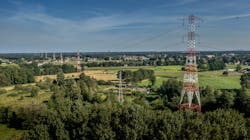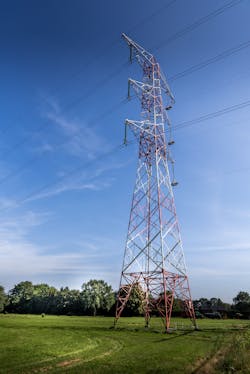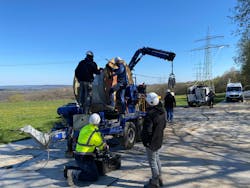Elia Tackles Grid Reliability Through New Technologies
The pressure on electrical energy utilities has never been greater with the race to strengthen, upgrade and build transmission system infrastructures able to accommodate increasing quantities of renewable energy. This requires significant work and investment often to fulfil government targets.
Many countries do not have sufficient renewable energy resources to meet their needs due to insufficient land space for onshore windfarms or the lack of a coastline for offshore windfarms. Transmission system operators (TSOs) must therefore be able to support the energy needs of their own customers and be capable of importing and exporting electricity across their borders.
Thus, the growing demand for electricity which in Europe is estimated to grow by some 70% by 2050 illustrates the magnitude of the challenges ahead.
A Sustainable Future
Elia, the Belgian subsidiary of Elia Group, is playing a large role in supporting efforts to tackle these challenges and facilitate the energy transition. The utility is committed to the United Nation’s (UN’s) Sustainable Development Goals and the European Union’s (EU’s) Green Deal, as demonstrated via the development and implementation of the Group’s ActNow Sustainability Program. ActNow published in January 2021 defines concrete and measurable objectives which embed sustainability across all of the group’s business processes.
Elia and 50Hertz (the group’s German subsidiary) both contribute to the fulfilment of ActNow objectives via their local ActNow Roadmaps. Moreover, Elia Group’s most recent publication, Road to Net Zero outlines the organization’s vision for building a climate-neutral energy system by 2050. Electricity will play a major role in reaching this objective because it is regarded as a low emissions source of energy for transportation and other uses. It will enable major societal shifts to occur, such as the growth of electric vehicles and the use of heat pumps in homes. Elia are also facilitating the connection of renewable energy resources such as solar panels and onshore and offshore wind farms to the transmission system as Belgium plans to adapt to a gradual nuclear phase-out by 2025.
Elia’s Consumer Centricity program promotes the building of smart houses and commercial premises which will include domestic appliances and equipment to use electricity when there is a surplus of cheap renewable energy. However, this will require collaboration with players from across the whole energy supply chain.
The success of these and other initiatives will hinge on the optimization of Elia’s operational systems to make them more flexible, reliable and efficient. Investment has already been made to increase the capacity of interconnectors that link Belgium with its neighbors — the Netherlands, the UK, Germany and France. More large-scale programs are being developed to increase the ability of Elia’s transmission system to transport more electrical energy.
Improvement in the transmission system infrastructure is the most important requirement for enabling the energy transition. Elia plans to connect more offshore windfarms in the coming years in the North Sea. However, the development of offshore wind resources must be coupled with onshore infrastructure development to transmit the renewable energy to regional load centers.
Advanced Overhead Line Conductors
Advanced conductors such as CTC Global’s ACCC conductors will have an important role for future transmission system infrastructure development as they can allow route capacity restraints and ground clearance issues to be addressed with minimal additional investment.
These advanced composite-based conductors generally have little or no requirement to strengthen the overhead line supporting towers (pylons), so the overall project costs associated with the use of these conductors is reduced. This advantage, coupled with the fact that the technology offers easier right-of-way (ROW) permitting procedures and the long-term transmission efficiency gains of between 25% and 40% in the load transfer capacity, results in significant savings over the entire lifetime of ACCC conductors compared with traditional aluminum steel-reinforced (ACSR) conductors.
Transmission Investments
One of Elia’s major projects is the upgrading of the Massenhoven-Meerhout-Van Eyck (MMVE) high-voltage (HV) overhead transmission line to enhance the capacity of a key connection in Belgium’s 380 kV transmission system. The MMVE line forms part of the backbone of Elia’s 380 kV transmission system, which efficiently transmits large quantities of electrical energy. With the share of renewable electricity in Belgium’s electricity mix set to increase, this project will allow Elia to transmit and disseminate these electricity flows faster and more effectively across the 380 kV transmission system. Furthermore, it will also facilitate the cross-border exchange of electricity between Belgium and the Netherlands, an interconnection which is vital to maintain the security of supply in Belgium.
The existing 380 kV overhead transmission line route between the Massenhoven and Van Eyck HV substations is approximately 92 km (57.2 miles) long. From the Massenhoven HV substation in Zandhoven the 380 kV overhead line is erected alongside the Albertkanal (Albert Canal) to the Geel and Meerhout HV substations.
The overhead line then continues onto the Van Eyck HV substation in Kinrooi/Masseik, which is near the borders of the Netherlands and Germany. This complete 380 kV overhead line spans 15 Belgian municipalities.
As a result of the complexity of the 380 kV overhead line upgrade and the time constraints imposed on this project, building a new connection was not a viable option. Therefore, Elia selected to employ new technology able to increase the load transfer capacity by reconductoring the 380 kV transmission system backbone with high temperature low sag (HTLS) composite core conductors. Thereby upgrading the 380 kV circuit between the Meerhout and Van Eyck HV substations.
The reconductoring of the 380 kV transmission line between the two HV substations began in early 2021, following intensive theoretical and intensive practical training of the installation team conducted by Lamifil and CTC Global staff. The circuit upgrade of this 380 kV three-phase, double-circuit, twin-conductored overhead line involved the installation of 395 km (245 miles) of CTC Global Arlington ACCC conductors in a “Z” profile manufactured by Lamifil in Belgium. As part of the contracted
On-Site Services (OSS), the structural integrity of each of the conductor drums were tested using CTC Global ACCC InfoCore System before and immediately
following conductor stringing. This time-critical upgrade project was subjected to the external pressures of the international supply chain difficulties and general logistics bottlenecks associated with the pandemic. Additionally, the pandemic also impacted on the installation and supervision workforce. Despite all these unforeseen problems, the project was successfully energized on target in Jan. 2022.
In 2023, Elia plan to upgrade the existing 380 kV transmission line between the Massenhoven and Meerhout HV substations using the same HTLS conductors in a project that is scheduled for completion in late 2024.
Deploying Composite Core
Ironically, CTC Global development of the ACCC InFoCore System was prompted by an incident (fault) involving an HTLS conductor in Belgium in 2018. The conductor breakage resulted in the 380 kV transmission line being unavailable for several days while the conductor was replaced.
The post-fault investigation on the conductor section that failed included a forensic examination including the use of microscopy a CT Scan and Scanning Electron Microscope (SEM) evaluation by research staff at the Catholic University of Leuven. The investigation revealed that excessive bending which probably occurred during installation of the conductor led to buckling or “compressive failure.”
Fortunately, while this is a rare occurrence, CTC Global were already working on embedded optical fiber systems when this breakage occurred. This incident accelerated their efforts to commercialize the system to ensure such events could be identified and rectified during the conductor stringing work prior to circuit energization.
Capturing Power Line Data
The ACCC InfoCore System uses optical fibers and robust data capturing and recording methodology. Each inspection can be performed in a few minutes a key advantage in the fast-moving field installation environments. The process involves accessing the conductor at each end and preparation of the core ends using tools provided in the ACCC InfoCore Confirmation Kit.
A transmitter and receiver are then attached to either end of the conductor and the controller receives, reviews and captures the result in the cloud. The whole process which is capable of confirming the integrity of each drum length takes around five minutes when the conductor ends are accessible. As the results are stored in a cloud-based project database, they can be accessed by the TSO (Elia) at any time during or after the project.
Upgrading Safely
The conductor failure incident in 2018 demonstrates the possible issues that can arise with early adopters of new technologies, like Elia. It also highlighted the way that challenges can drive innovation with promising outcomes.
The initial ACCC InfoCore System prototype was first tested as part of a pilot project that was undertaken during the installation of Oslo ACCC conductors near Mons in Belgium in early 2020. The work involved enhancing the transmission capacity to cater for Crystal Computing’s requirements, which included the upgrading and re-routing of the existing double-circuit 150 kV transmission line. By replacing the original AAAC-2Z 346 conductors with ACCC Oslo conductors the transmission capability of the circuit was increased by 130 MVA.
In 2020, Elia installed a total of 250 km (155 miles) of CTC Global’s Antwerp ACCC ULS conductors that offer added strength on a 40 km (245 mile) length of transmission line between Horta and Avelgem. This 380 kV transmission line forms part of the upgraded interconnector between France and Belgium effectively doubling the existing circuit’s load transfer capacity.
Elia now specifies the use of the ACCC InfoCore System technology in all project contracts that involve the installation of advanced composite core conductors. They firmly believe that this improves a project’s reliability and it is a safe, fast and inexpensive way of confirming that the composite core conductor has been successfully installed.
More Changes Ahead
With the predicted changes ahead for the energy sector, utilities have work to do to ensure the resilience, affordability and efficiency of their transmission systems. Elia have demonstrated that they are at the forefront of grid innovations to meet the future challenges associated with the energy transition.
As utilities respond to government and customer requests to improve the reliability, affordability and efficiency of their networks, transmission system operators such as Elia in Belgium are strengthening and maximizing the capacity of their existing networks by introducing new technologies. These include dynamic line rating (DLR) and the use of advanced conductors to increase system capacity, alleviate grid congestion and ultimately facilitate the current energy transition.
Jean-Francois Goffinet ([email protected]) is a senior expert on primary systems at Elia Engineering and is a member of CIGRE, IEC and CENELEC. Goffinet is based in Brussels, Belgium.
About the Author
Jean-Francois Goffinet
Jean-Francois Goffinet is a senior expert on primary systems at Elia Engineering SA and has 20 years of experience in the design of overhead lines. He is a member of CIGRE, a Belgian representative of Study Committee B2 on overhead lines, a member of the International Electrotechnical Commission (IEC), and a member of the European Committee for Electrotechnical Standardization (CENELEC) work groups on conductors and overhead lines. Goffinet has been involved in more than 20 publications.



